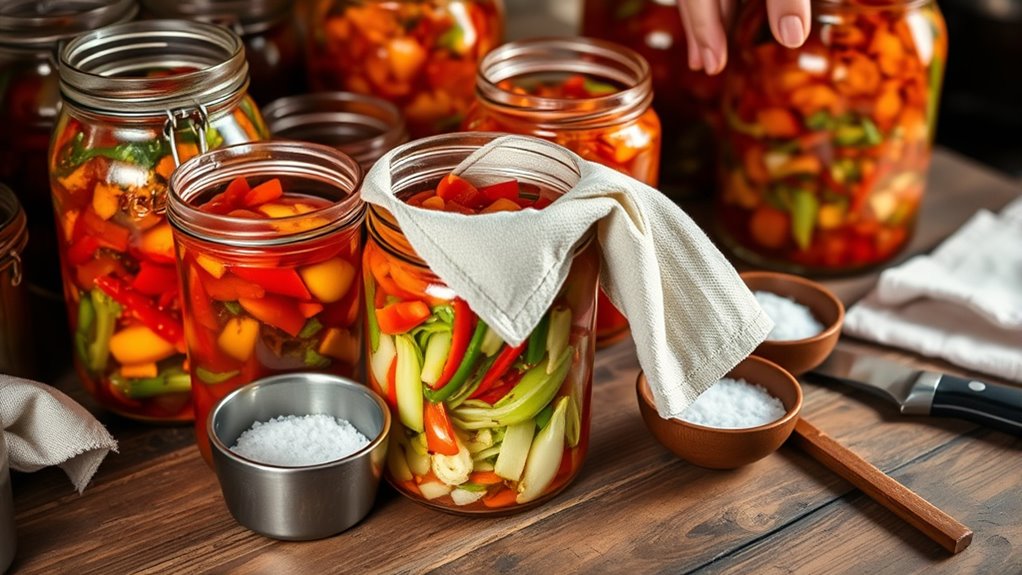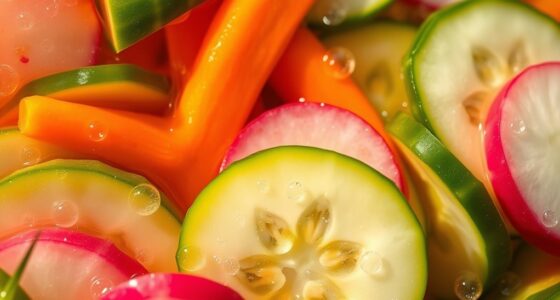To start your first batch of kimchi tonight, select fresh, clean cabbage and vegetables, then season them with salt and spices. Pack everything into a sanitized jar, making sure the vegetables are fully submerged under the brine to prevent mold. Store in a cool, dark spot, and check daily to guarantee the vegetables stay submerged and fermentation bubbles form. Proper sanitation and environment control are key. If you’re interested in mastering the process, more details await.
Key Takeaways
- Use fresh, thoroughly cleaned ingredients and sanitized utensils to prevent contamination and ensure successful fermentation.
- Keep the vegetables submerged in the brine and store the jar in a cool, dark place for optimal fermentation conditions.
- Check daily to ensure vegetables remain submerged and watch for bubbles indicating active, healthy fermentation.
- Discard batches with mold or spoilage signs to prevent health risks and ensure safety.
- Taste after a few days to monitor flavor development and fermentation progress for the best kimchi.

Have you ever wondered how foods like yogurt, sauerkraut, or kombucha develop their unique flavors? It all comes down to fermentation—a natural process that transforms simple ingredients into vibrant, tangy, and nutritious foods. When you start your own fermentation, you’re not just making a tasty dish; you’re also boosting your probiotic health by introducing beneficial bacteria into your gut. These tiny microbes play a vital role in improving digestion, strengthening your immune system, and maintaining overall well-being. But before you dive in, it’s essential to understand fermentation safety to guarantee your homemade kimchi turns out delicious and safe to eat.
First, gather your ingredients: fresh cabbage, salt, and any spices or vegetables you like. Clean everything thoroughly to prevent unwanted bacteria from contaminating your batch. Proper sanitation is key—use clean utensils, jars, and gloves if needed. Once your vegetables are chopped and salted, they’ll start releasing water, creating a natural brine that encourages the growth of good bacteria while inhibiting harmful pathogens. This is the core of fermentation safety: maintaining the right environment so beneficial microbes dominate. Keep your jar in a cool, dark spot, and check it daily to make sure the cabbage remains submerged under the brine. This prevents mold and spoilage, safeguarding both your health and the integrity of your kimchi.
Start with fresh ingredients, sanitize equipment, and keep vegetables submerged for safe, successful fermentation.
As fermentation progresses, you’ll notice bubbles forming—proof that beneficial bacteria are actively fermenting the sugars into lactic acid. This acid not only gives kimchi its signature tang but also acts as a natural preservative, extending its shelf life. The acidity also helps maintain probiotic health by keeping the environment inhospitable to harmful bacteria. To guarantee safety, always use fresh ingredients, avoid overfilling your jar, and keep everything properly submerged. If you see any mold, discard the batch—it’s better to start fresh than risk foodborne illness. Tasting your kimchi after a few days will reveal a developing flavor profile—sour, savory, and complex—thanks to the ongoing fermentation.
Additionally, understanding fermentation safety is crucial, as it involves controlling environmental factors like temperature and cleanliness to prevent spoilage and ensure beneficial bacteria dominate. Starting your first batch of kimchi is straightforward if you follow proper fermentation safety guidelines. The process not only yields delicious food but also enhances your probiotic health by providing live beneficial bacteria. Remember, cleanliness, patience, and attention to detail are your best tools for a successful fermentation. With each batch, you’ll become more confident and better at creating flavorful, healthy foods at home. So why not begin today? Your homemade kimchi will reward you with vibrant flavors and a boost to your gut health, proving that fermentation is both an art and a science worth mastering.
Frequently Asked Questions
How Long Does Homemade Kimchi Typically Last in the Fridge?
You might wonder how long homemade kimchi stays good in your fridge. Typically, its storage duration is about 3 to 6 months, but always watch for spoilage signs like an off smell, mold, or slimy texture. As it ferments, it develops a stronger flavor, so taste it periodically. Properly stored in a sealed container, your kimchi can last longer, but trust your senses to determine if it’s still safe to enjoy.
Can I Use Non-Traditional Vegetables for Fermentation?
Absolutely, you can use vegetable substitutions for fermentation diversity. Non-traditional vegetables like carrots, radishes, or even zucchini work well, adding unique flavors and textures. Just guarantee they’re fresh, clean, and cut appropriately to promote proper fermentation. Experimenting with different vegetables allows you to customize your fermentation, making each batch special. Keep in mind, some vegetables may ferment faster or slower, so monitor and adjust your process as needed.
What’s the Best Way to Prevent Mold During Fermentation?
Imagine you’re a modern-day explorer steering fermentation’s seas. To prevent mold, guarantee good air circulation around your ferment, as stagnant air invites unwanted mold. Use mold-resistant containers that discourage mold growth. Keep your ferment submerged under brine or weight, and maintain a consistent temperature. These steps help create a hostile environment for mold, ensuring your kimchi ferments beautifully without spoilage.
How Do I Know if My Kimchi Has Fermented Properly?
You’ll know your kimchi has fermented properly when it develops a tangy smell and a slightly sour taste, indicating the right flavor development. During the fermentation timeline, you should see bubbles and slight fizz, showing active fermentation. If it’s been a few days at room temperature, trust your senses—if it smells off or develops mold, discard it. Proper fermentation results in vibrant flavor and safe, delicious kimchi.
Are There Any Common Mistakes to Avoid When Starting Fermentation?
When starting fermentation, avoid common mistakes like neglecting fermentation safety and poor ingredient selection. Always guarantee your vegetables are clean to prevent harmful bacteria, and use fresh, quality ingredients for the best results. Don’t rush the process or expose your kimchi to extreme temperatures, as it can spoil or develop off-flavors. Properly balancing salt and ensuring a clean environment helps your kimchi ferment safely and develop authentic flavor.
Conclusion
Now that you’ve started your first batch of kimchi, think of fermentation like planting a seed—you nurture it patiently, and it transforms into something vibrant and full of life. I remember my first attempt; after a week, the smell alone sparked excitement, just like watching a tiny sprout break through the soil. With each batch, you’ll learn more and enjoy the process. So, keep experimenting and savor the delicious results—your kitchen is now a fermentation garden!









